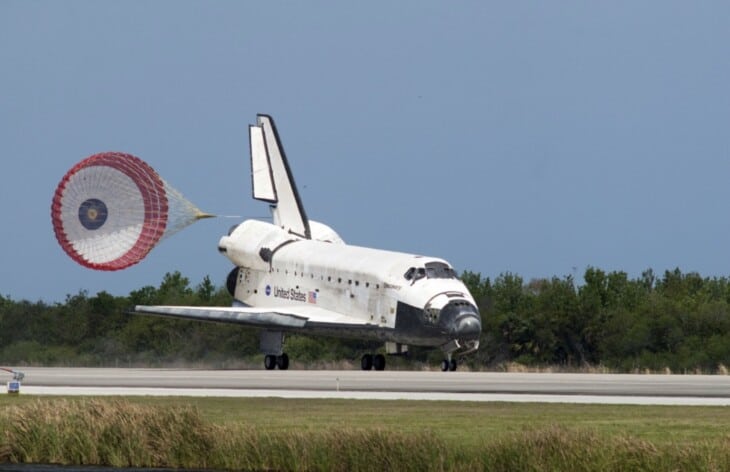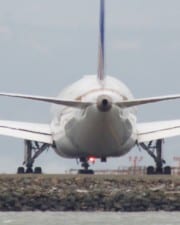Many people realize that drag is a factor in how something looks or how sleek it is. But aircraft make many different kinds of drag. So to design a plane, or even just to operate one, you have to have an idea of what makes each type of drag better or worse.
What is Drag in Aviation?
Put simply, drag is the resistance to the forward movement of an aircraft. It is opposite thrust, so the more drag an aircraft has, the more power it will need. Drag is one of those infamous four forces of flight that every pilot needs to master. Next to lift, it’s the force with the most details to talk about.
Drag is one of the four fundamental forces that act on an airplane in flight. It is the force that holds a plane back and resists the forward thrust created by the engine.
What Causes Drag on an Airplane?
Drag is created by air passing over the airplane. But the two main types of drag, induced and parasite, are created differently.
Of the two, parasite drag is the easiest to visualize. Parasite drag is created by anything that is moved through the air. The shape of the object–whether it’s a box or a streamlined shape–means that some objects create more drag than others. But everything makes drag as the air resists its movement.
The second type of drag, induced drag, is created by the wing when it makes lift.
What Are the Different Types of Drag?
There are quite a few ways aircraft make drag, so figuring out exactly how many kinds there are takes a moment of thinking and categorizing.
Essentially, there are two different types of drag–induced and parasite.
But parasite drag is formed in multiple ways, so there are also three types of parasite drag you should know.
The types of airplane drag are:
- Induced Drag
- Parasite Drag
- Form Drag
- Interference Drag
- Skin Friction Drag
Induced Drag
Induced drag is a byproduct of lift–anytime an airfoil (an airplane’s wing, helicopter’s rotor, or engine propeller) makes lift, it will also make drag. In some ways, this is a real-world example of how no mechanical system works at 100 percent efficiency. As a result, there’s always some amount of waste.
If you study how planes make lift and learn about Bernoulli’s Principle, you might notice that the wing’s lift is produced perpendicular to the average relative wind. Simply put, a wing doesn’t produce its lift entirely straight up and opposite gravity. Some of it, unfortunately, is always pointed backward and opposite thrust. So what’s the force that acts opposite thrust? Drag.
Another side effect of induced drag is the creation of wingtip vortices. These spiral off the tips of the wings, taking energy away from the creation of lift and wasting it by making spirals in the air column.
The amount of induced drag changes dramatically during flight. As a wing’s angle of attack increases, the induced drag increases.
Parasite Drag
Parasite drag gets its name because it is parasitic in nature. In other words, no part of it is helpful when flying a plane, and reducing it in aircraft design is always a good thing.
The more air passing over a plane, the more parasite drag is produced. So, in the real world, the faster a plane flies, the more parasite drag it makes. This is why fast planes need to look sleek, and slow planes can look, well, slow.
Parasite drag increases by the square of the airspeed. So a doubling of your speed will make four times as much drag. Yikes!
There are three types of parasitic drag, and understanding each type will help you understand the concept as a whole.
Form Drag
Form drag comes from the shape of an object. Since everything that passes through the air has drag, then the shape can help us control the amount of drag it has.
If you compare different aircraft types, you can immediately identify those which make more form drag than others.
Think about the shape of a landing gear strut on a simple Cessna or Piper. The simplest strut might be a rectangular bar of spring steel. But when this is moved through the air, it creates a lot of drag.
Another option might be a round tube of spring steel. This is better than a rectangular bar, for sure. But it also creates substantial drag as the air bends around the shape.
The best option is a strut with a fairing around it. It is tapered to a point on the leading and trailing edges, making it look almost like a wing. This passes through the air with the least amount of drag. It still makes parasite drag, but less than the rectangular or circular options.
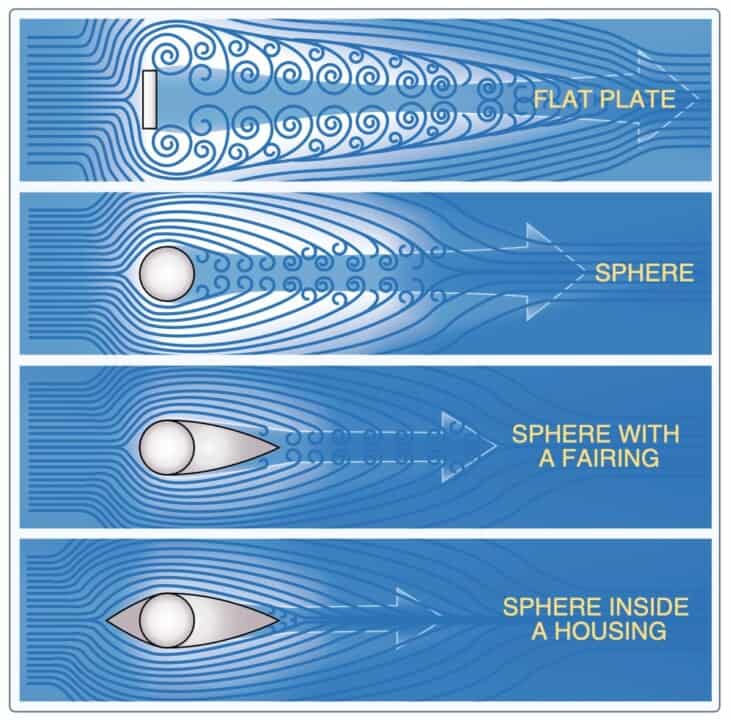
Designers work to minimize form drag in many ways. The most obvious way is the way that the landing gear retracts. Tucking the landing gear away into the belly of the plane reduces the entire plane’s form drag substantially.
For some planes, like the Shorts 330 cargo plane, an amount of form drag is necessary to meet the design criteria. Likewise, an F-16 Fighting Falcon has less form drag because its design requires the most speed possible.
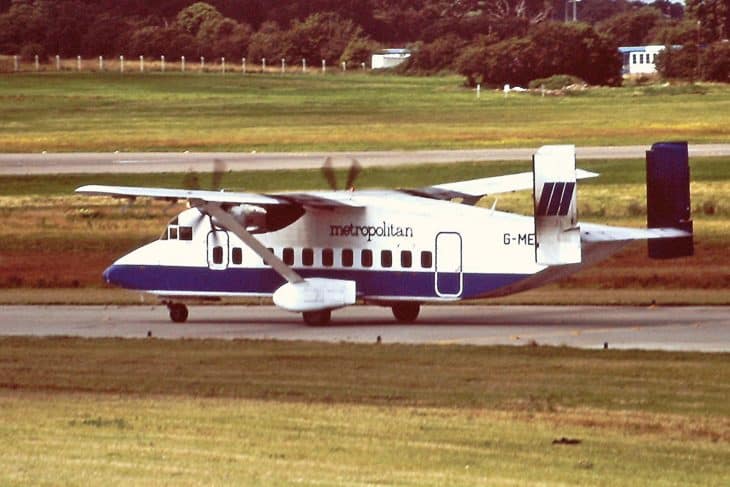

Interference Drag
Interference drag is harder to visualize, but basically it results from any place on an aircraft where two surfaces meet.
One example is the wing root, where the wings attach to the fuselage. The joint between the two creates its own drag, so the total drag created by the wing and fuselage combination is greater than the wing alone added to the fuselage alone.
In aircraft design, it’s easy to see where interference drag causes problems because fairings will be installed on the aircraft. A fairing is a simple structure of skin that reduces the angle where two things meet.
Many aircraft have fairings at the wing roots, and they are also common on the empennage and landing gear struts.

Skin Friction Drag
Finally, the surface that the air passes over will also cause drag. If the surface is rough, it will resist air flow more and make more skin friction drag.
A common example of skin friction drag is a clean airplane next to a clean, waxed, and polished airplane. The glossy surface of the polished paint presents little resistance to air flowing over it.
The dirty airplane, covered in paint chips and bug carcasses, presents more obstacles to the air flowing along its surface. It makes more skin friction drag as it flies, so it will be slower and burn more fuel than its clean counterpart.
Of course, if you viewed the clean plane under a microscope, it would still have a rough surface that made drag. It just makes less drag than the dirty one.
In the world of light aircraft, rivets are often used to bond pieces of aluminum skin. If you study the wing surface of one of these aircraft, you’ll notice that the rivets are cleverly arranged one behind the other to reduce the amount of drag.

You may also notice that they use the more expensive flush rivets along the wing’s leading edge, where regular rivets would create more drag than on the trailing edge.
Some planes use adhesives to replace the rivets. Composite aircraft have no rivets, so their designs tend to have lower drag (but they are usually sleeker, so form and interference drags are also reduced.)
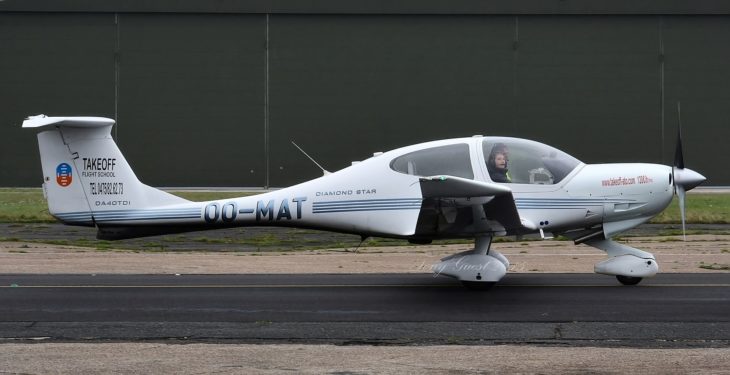
Laminar flow is another tool designers use to reduce skin friction drag. The idea is that a thin skin of air along the plane’s surface doesn’t move that fast. This air, known as the boundary layer, can more or less be adhered to the surface, and its shape can be controlled. Then, the air passing over the top of the boundary layer will have much less drag since it is basically flowing over a layer of air.
Designers have a few tools in their tool bags to control the shape of the boundary layer to reduce drag. One of them is the vortex generator, small tabs installed on the leading edge of high-lift wings that give them more lifting power and less drag.
The Relationship of Speed and Drag During Flight
The fact that one type of drag increases when you go slower (induced drag) and the other type increases as you go faster (parasite drag) has big implications for pilots.
One of the first exercises a new pilot learns is how to fly the airplane very slowly. As the plane slows down, induced drag goes up. This means that, without action by the pilot, the plane would keep slowing down until it stalled.
The only way to get the plane to fly stably at a low airspeed is to add more thrust from the engine to counteract the more drag the wings make. So, somewhat counterintuitively, the pilot must add more power to go slow.
There’s not much a pilot can do to counteract the increased parasitic drag made by the plane going fast. Every plane comes with limitations, and the amount of force on the aircraft is a factor of how much parasitic drag is being produced. In other words, maximum airspeeds like Vno and Vne exist for a reason. If you exceed them, the drag could tear a plane apart.
References ▾
Related Posts
